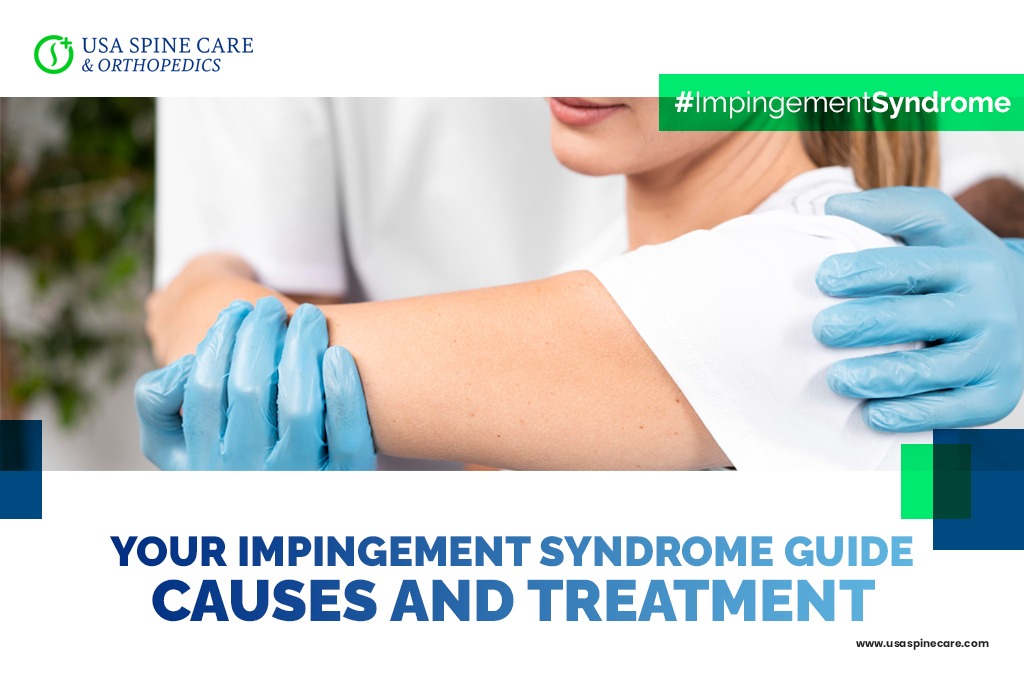- Conditions
- Procedures
- Patient care
- Why choose us
- Our Doctors
- Contact
Your Impingement Syndrome Guide — Causes and Treatment

Getting diagnosed with an injury like impingement syndrome can be a source of added anxiety for many people. In addition to the shoulder pain and limited mobility, learning that the source of your symptoms is such a serious-sounding condition may add to your uncertainty. Fortunately, impingement syndrome is usually a treatable injury that can improve with time and proper care.
One of the best things you can do as a patient with impingement syndrome is educate yourself about the causes and effective treatment options. This can help you be more involved with your treatment as you work with your doctor to find the relief you’re looking for.
To help, the team at USA Spine & Orthopedics has put together the following guide to impingement syndrome. As you take a moment to review this information, don’t hesitate to get in touch with us if you are ready to take the next step in your treatment journey.
Primary causes of shoulder impingement syndrome
Impingement syndrome is a shoulder injury that occurs when tendons that help form the rotator cuff become trapped, or impinged, between the upper arm and the tip of the shoulder. There can be a wide range of causes for this, but the most frequent is sports-related injury due to repetitive motion. Impingement syndrome is so often associated with swimming that it is sometimes called, “swimmer’s shoulder.”
Other causes and risk factors include age and the presence of arthritis, which can contribute to further constriction of the rotator cuff and shoulder joint. Some people also have a natural bone structure that creates an increased chance of developing impingement syndrome.
Typical treatments include rest and anti-inflammatory medication
Doctors typically diagnose impingement syndrome in one of three stages. The first is basic pain and inflammation that limits the ability to lift the arm above the head and lower it down. The second phase is rotator cuff tendinitis and shoulder fibrosis that can further inhibit movement and pain. By the third stage, patients may be at risk for ruptured tendons and the development of bone spurs that can cause long-term shoulder dysfunction.
Because of this, the earlier that the condition can be diagnosed and treated, the better. Initial treatments, especially for stage one impingement syndrome, include basic conservative therapies such as:
- Resting the shoulder
- Modifying activities to limit stress on the shoulder joint and rotator cuff
- Performing gentle therapeutic stretches
- Taking anti-inflammatory medication, such as naproxen or ibuprofen
In later stages, or if the injury does not improve, patients can also undergo physical therapy and receive pain-relieving anti-inflammatory shoulder injections.
Should you ever consider surgery?
If weeks or months of conservative therapy does not improve the injury, or it begins to worsen, surgery can become a consideration. The primary goal of any surgical procedure for shoulder impingement syndrome is to create space in the shoulder for the rotator cuff tendons to move freely.
This often involves arthroscopic techniques that can be performed on an outpatient basis. Minimally invasive arthroscopic surgery is designed to limit muscle soft tissue disruption to enable a faster healing time and limit the risk of certain complications. After the procedure patients will undergo physical therapy and shoulder rehabilitation to be able to resume normal activities.
The shoulder experts at USA Spine & Orthopedics can help
At USA Spine & Orthopedics our multidisciplinary team has extensive experience helping patients with shoulder impingement syndrome overcome their injury and find the relief they deserve. We believe in patient-centered care, and will help you develop a personalized treatment plan that is built around your unique diagnosis and lifestyle.
From pain-relieving injections to arthroscopic surgery at our state-of-the-art outpatient centers, we can get you back to the people and activities you’ve been missing. Contact us today to learn more.
Call 1-813-773-3050
Impingement Syndrome Quick Answers
How do you know if you have shoulder impingement?
The telltale sign of shoulder impingement syndrome is pain, weakness and/or stiffness when you try to raise your arm above your head, or out to the side of the body. These symptoms can also occur when lowering your arm. Other issues include a grinding or catching sensation when performing certain arm movements and difficulty sleeping.
What is the cause of shoulder impingement?
Impingement syndrome occurs when tendons in the rotator cuff become pinched, or impinged, by between the tip of the shoulder and the top of the arm. This is commonly a sports-related injury, especially due to tennis or swimming, where people put repetitive stress on the shoulders. Other causes can include natural bone structure, aging, and the development of bone spurs.
What are the stages of impingement syndrome?
No two cases of shoulder impingement are the same, but many doctors classify three distinct stages for the injury. The first is early inflammation and pain, the second is often the development of tendinitis and painful formation of fibrous tissue and the third is the potential for ruptured tendons and development of bone spurs that further inhibit motion. The progressive nature of many cases of shoulder impingement underscores the need for a proactive approach to treatment.
How do you treat impingement syndrome?
Shoulder impingement syndrome can improve with proper rest and treatment. Doctors will recommend modifying activities to reduce painful movement, anti-inflammatory medications to reduce pain and swelling, and hot and/or cold compression therapy. Physical therapy and steroid injections may be recommended in more severe cases. If conservative treatment does not help improve the injury, surgery can become a serious consideration.
